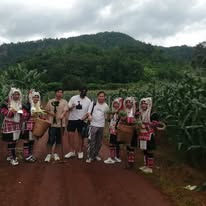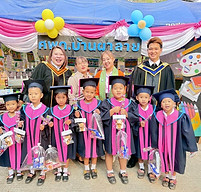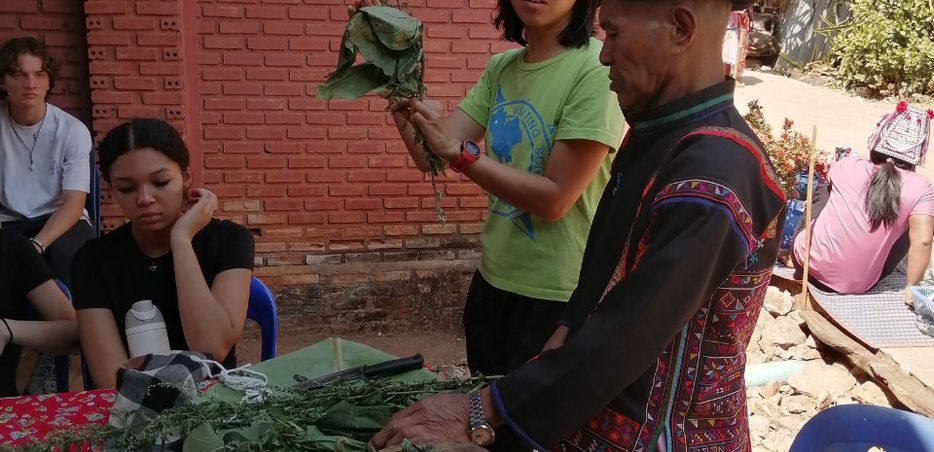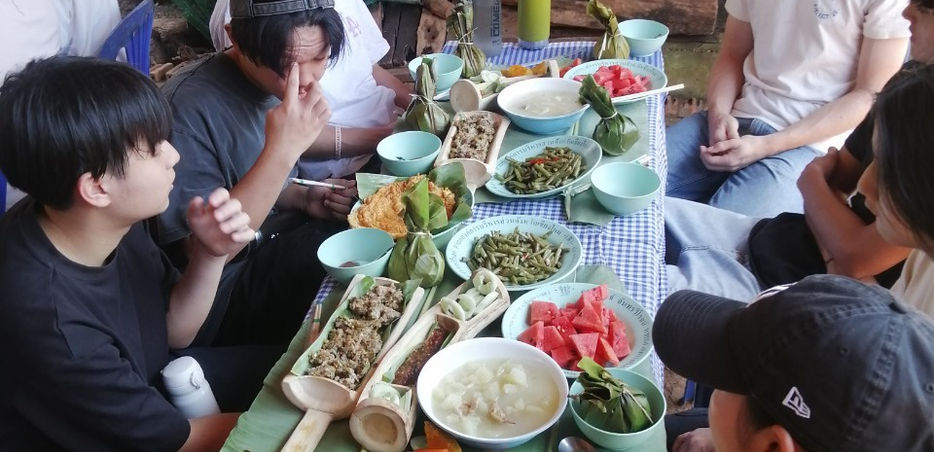
ศรส. บ้านผาลาย
ช่องทางติดต่อ
General information about the community
Ban Phalai Learning Center is one of the 10 centers of the SRS.
We focus on improving the quality of life of the Akha community through education and sustainable development.
The area is a centre for learning and training that addresses community needs in areas such as sustainable agriculture, vocational training, handicrafts and community tourism development.
Ban Phalai Learning Center is also a place to continue Akha culture, support the preservation of local wisdom, and promote the community economy through agricultural products, processed products, and unique handicrafts.
Basic information
address : Ban Phalai, Village No. 16, Ban Luang Subdistrict, Chom Thong District, Chiang Mai Province 50170
Area: 7,130 rai
Ethnicity : Karen, Lisu, Akha

History of Ban Phalai
In 1907, the Pga K'nyau tribe migrated from Ban Mae Na, Chiang Dao District, which was the first tribe to settle in the area and named the village "Ban Huai Ko". Huai means a watercourse from the mountain, while Ko is the name of a type of tree in the Pga K'nyau language. It is a tree located at the headwaters to the east of the community. It has a distinctive, large, beautiful tree, and the villagers believe that it is an auspicious tree and that there are sacred things living in the tree according to the beliefs of the Pga K'nyau people. Therefore, it is the origin of the name of the village at that time.
In 1975, the Lisu people migrated to settle in a village near the Karen people. The Karen people moved to live next to a mountain called “Pha Daeng”.
In 1982, the Akha tribe moved to settle in a village in the same area as the Lisu people, who had migrated from Mae Chan District, Chiang Rai Province. In this area, in addition to the stream called Huai Ko, there were many other streams, such as Huai Mae Phrik, Huai Yao, and Huai Ton Yang. The landscape was surrounded by limestone mountains, with intricate cliffs of various colors, along with many large and small trees. At that time, Ban Huai Ko was a village of Ban Tung Luk, Village No. 9, Chiang Dao Subdistrict, Chiang Dao District, Chiang Mai Province. Later, the number of households and the population in the community increased steadily.
In 1999, Ban Huai Ko requested to separate from Ban Thung Luk to establish a new village, Village No. 16, Chiang Dao Subdistrict, Chiang Dao District, Chiang Mai Province, along with giving it a new name, "Ban Pha Lai", in accordance with the characteristics of the mountainous area and cliffs that are beautifully intricate. There have been official leaders or village headmen since then, with Mr. Suphat Tahna being the first village headman and the second being Mr. Sarawut Yaepia.
Current information
At present, Ban Pha Lai is located at Village No. 16, Chiang Dao Subdistrict, Chiang Dao District, Chiang Mai Province, to the east, 15 kilometers from Chiang Dao District, 825 meters above sea level. It is a community with three ethnic groups living together, namely the Karen, the Lisu, and the Akha, and is divided into three villages. Important places are:
3 Christian churches
1 temple
1 early childhood development center
1 Highland Community Education Center (HCEC)
ข้อมูลปัจจุบัน
บ้านผาลายตั้งอยู่ที่ หมู่ที่ 16 ตำบลเชียงดาว อำเภอเชียงดาว จังหวัดเชียงใหม่ ห่างจากตัวอำเภอเชียงดาวประมาณ 15 กิโลเมตร ไปทางทิศตะวันออก และตั้งอยู่สูงจากระดับน้ำทะเลประมาณ 825 เมตร
ปัจจุบันชุมชนบ้านผาลายมีพี่น้องชาติพันธุ์อาศัยอยู่ร่วมกัน 3 กลุ่ม ได้แก่
-
ชนเผ่าปกาเกอะญอ
-
ชนเผ่าลีซู
-
ชนเผ่าอาข่า
ชุมชนบ้านผาลายกระจายกันตั้งอยู่ใน 3 หย่อมบ้าน และมีสถานที่สำคัญภายในชุมชน ได้แก่
โบสถ์คริสต์ 3 แห่ง
วัด 1 แห่ง
ศูนย์พัฒนาเด็กเล็ก 1 แห่ง
ศูนย์การศึกษาสำหรับชุมชนบนพื้นที่สูง (ศศช.) 1 แห่ง
หมู่บ้านแห่งนี้ยังคงรักษาวิถีชีวิตเรียบง่ายที่กลมกลืนกับธรรมชาติ และสะท้อน อัตลักษณ์วัฒนธรรมของชาติพันธุ์ทั้งสามอย่างงดงาม



Territory area
The area of Ban Pha Lai Village, Village No. 16, Chiang Dao Subdistrict, Chiang Dao District, Chiang Mai Province is 15 kilometers away from Chiang Dao District and 87 kilometers away from Mueang Chiang Mai District, Chiang Mai Province. It has the following borders:
The north side is adjacent to Ban Pang Mayao, Ping Khong Subdistrict, Chiang Dao District.
The south is adjacent to Ban Mae Jon, Chiang Dao Subdistrict, Chiang Dao District.
The east side is adjacent to Ban Pang Tong, Ping Kong Subdistrict, Chiang Dao District.
The west side is adjacent to Ban Pang Daeng Nai and Ban Pang Daeng Nok, Chiang Dao Subdistrict, Chiang Dao District.

Total area of the community
1. National forest reserve area, accounting for 80 percent
2. Sri Lanna National Park area, accounting for 20 percent
Total area 7,130 rai
Topography
Ban Pha Lai community has a topography similar to a basin, surrounded by intricate limestone mountains, cliffs, and large and small trees. Most of the forest area is mixed deciduous forest and dry dipterocarp forest. There are many wild animals such as barking deer, goral, serow, wild boar, monkeys, pheasants, jungle fowl, pheasants, wolves, monitor lizards (land), and many types of birds.






Important places in the community
Ban Pha Lai is located in Village No. 16, Chiang Dao Subdistrict, Chiang Dao District, Chiang Mai Province. It is a community with cultural and natural diversity. Interesting tourist attractions in this community include:
1. Ban Phalai Community Forest
The national forest reserve area that the community jointly looks after and preserves covers an area of approximately 59 rai, 3 ngan, and 62 square wa. Tourists can walk through nature and learn about the community's forest conservation.
2. Akha Tribal Handicraft Center
A place where the Akha people produce and sell handicrafts such as hand embroidery, shirts, hats and various accessories. Tourists can visit and buy unique products.
3. Mae Fah Luang Hilltribe Community Learning Center (MHCL)
Educational institutions that provide educational services to children and youth in the area. Tourists can visit and learn about the community's education system.
4. Purple Tree Cave
Tham Ton Muang is a natural cave. The cave is a large cavity deep in the mountain rock. It is large. The cave is made up of stalactites and limestone. It has a sparkling light that sparkles like diamonds. You cannot go deep into it because it is just a large cavity with no path.
5. Huai Ko Cave
Huai Ko Cave is a natural cave. The cave features stalactites and limestone. It is a deep hole in the ground or mountain, large enough for humans to enter and visit. The mouth of the cave is 3 meters wide. Deep inside is a large hole and there is a path that allows us to enter deeply. At some points you can walk, at some points you have to bend down. I am not sure how difficult the distance is (because I have never explored it).
6. Ban Phalai Monastery
Religious places used for Buddhist ceremonies or as places of merit for ethnic Buddhists. Tourists can visit and learn about Buddhist beliefs.
7. Ban Phalai Child Development Center
Educational institutions that provide training, provide experiences and promote development, learning for young children to be ready physically, emotionally - mentally, socially and intellectually. Under the governing organization, namely, Chiang Dao Subdistrict Administrative Organization, tourists can visit and learn about the education system of the center.
8. Church of Christ
Religious places used for Christian ceremonies are considered another place for Christian tribes to use for religious ceremonies to worship God. The Ban Phalai community has 3 churches, or 1 church per village. Tourists can visit and learn.
9. Viewpoint: Mon Pai Huai Ko Farmstay
It is a mixed agricultural tourism destination. It is an agricultural system where various types of plants are grown in the same area under mutual support and benefit. It is a place built for relaxation and viewing the beautiful atmosphere of nature. Tourists can visit and learn about mixed agricultural management or come to relax at Mon Phai Huai Ko Farmstay.
In addition, Ban Pha Lai community also offers cultural and natural tourism activities such as nature trail trekking, learning about the lifestyles and cultures of various tribes, which tourists can join to experience the real community.





Learning resources within the community
It is a demonstration center that transfers tangible knowledge in improving the quality of life of people in the highlands. The learning base is in the community, divided into the following areas:
1. Economic learning resources
1) Akha Tribal Handicraft Learning Base
Base Speaker: Ms. Saowalak Yehlong
2) Weaving learning base
Base lecturers: Mr. Ase Asong, Mr. Apha Kuyi
2. Social learning resources
1) Auspicious Egg Learning Base
Base lecturer: Ms. Kannika Rattanakulchai
2) Akha Rice Cracker Learning Base
Base lecturer: Ms. Kannika Rattanakulchai
3) Akha Local Food Learning Base
Base lecturer: Ms. Pookum Mopokoo
4) Learning base to learn the Akha way of life
Base Speaker: Mr. Sopon Rattanakulchai
5) Little tour guide learning base
Base Speaker: Children in the community
6) Akha singing and dancing learning base
Base Speaker: Mr. Akang Mepuku
3 environmental learning resources
1) Herbal learning base
Base Speaker: Mr. Lao Er Ye Lung
2) Hiking learning base
Base Speaker: Mr. Akang Mepuku
3) Learning base for watershed forest care
Base Speaker: Mr. Sopon Rattanakulchai
4) Water Detective Learning Base
Base Speaker: Mr. Ekkasit Yehlong
Community economic groups
1) Akha Huai Ko Community Tourism Group
2) Ban Phalai Tribal Handicraft Group
3) Mon Pai Huai Ko Farmstay
4) Youth career development group
Support agencies
1) Plan International Organization (Thailand)
2) High land development project like the Pang Daeng Royal Project
3) The Association of Hilltribe Education and Culture Centers in Thailand (IMPECT)
4) Chiang Mai Breath Council
5) Health Promotion Fund (ThaiHealth)
6) Chiang Dao Subdistrict Administrative Organization
7) Chiang Dao District Office
8) Chiang Dao District Agricultural Office

กิจกรรมโดยพันธมิตรของพวกเรา
ศูนย์เรียนรู้เพื่อการพัฒนาคุณภาพชีวิตชุมชนบนพื้นที่สูงเชียงใหม่ หรือ ศรส. (Highland Learning Center: HLC) พวกเรามุ่งมั่นในการ ยกระดับคุณภาพชีวิตของกลุ่มชาติพันธุ์ที่อาศัยอยู่บนพื้นที่สูงผ่านกระบวนการเรียนรู้ การพัฒนา และการสนับสนุนที่ยั่งยืนเราทำงานร่วมกับชุมชนเพื่อส่งเสริมการศึกษา อาชีพ สุขภาวะ และสวัสดิการสังคม โดยใช้แนวทางที่สอดคล้องกับวิถีชีวิต วัฒนธรรม และทรัพยากรท้องถิ่นเราทำงานร่วมกับภาคีเครือข่าย เช่น ศูนย์พัฒนาราษฎรบนพื้นที่สูงจังหวัดเชียงใหม่ และ กรมพัฒนาสังคมและสวัสดิการ เพื่อผลักดันโครงการที่ช่วยเพิ่มโอกาสและศักยภาพให้กับประชาชนบนพื้นที่สูง นำไปสู่ความเป็นอยู่ที่ดีขึ้นและความเข้มแข็งของชุมชนในระยะยาวเราพร้อมเป็นสะพานเชื่อมต่อโอกาส และเป็นศูนย์กลางการเรียนรู้ที่เปิดโอกาสให้ทุกคนได้เติบโตไปด้วยกัน
วิเคราะห์ศักยภาพชุมชนหมู่บ้านผาลาย
ณ หมู่บ้านผาลาย ต.เชียงดาว อ.เชียงดาว จ.เชียงใหม่
(กลุ่มชาติพันธุ์อาข่า)
27 มกราคม 2568
09:00 - 16:00
วิเคราะห์ศักยภาพชุมชนบ้านแม่แดดน้อย
ที่ หมู่บ้านแม่แดดน้อย
ต.แม่แดด อ.กัลยาณิวัฒนา จ.เชียงใหม่ (กลุ่มชาติพันธุ์กะเหรี่ยงปกาเก่อญอ)
30 มกราคม 2568
09:00 - 16:00
วิเคราะห์ศักยภาพชุมชนบ้านปางเติม
ที่ หมู่บ้านปางเติม ต.แม่สาบ อ.สะเมิง จ.เชียงใหม่
(กลุ่มสะเมิง organic)
28 มกราคม 2568
09:00 - 16:00
วิเคราะห์ศักยภาพชุมชนบ้านหนองเจ็ดหน่วย
ที่ หมู่บ้านหนองเจ็ดหน่วย
ต.บ้านจันทร์ อ.กัลยาณิวัฒนา จ.เชียงใหม่ (กลุ่มชาติพันธุ์กะเหรี่ยงปกาเก่อญอ)
31 มกราคม 2568
09:00 - 16:00
วิเคราะห์ศักยภาพชุมชนบ้านป่าเกี๊ยะน้อย
ที่ หมู่บ้านปางเติม ต.แม่นาจร อ.แม่แจ่ม จ.เชียงใหม่
29 มกราคม 2568
09:00 - 16:00
วิเคราะห์ศักยภาพชุมชนบ้านแม่สาน้อย
ที่ หมู่บ้านแม่สาน้อย
ต.โป่งแยง อ.แม่ริม จ.เชียงใหม่ (กลุ่มชาติพันธุ์ม้ง)
4 กุมภาพันธ์ 2568
09:00 - 16:00
Important annual culture and traditions
1) The tradition of Maesunglo, feeding the spirits of the forest and mountain in March
2) Akha New Year tradition (red eggs) in April (playing with spinning tops, saba balls)
3) Swing Festival (end of August, beginning of September)
4) The tradition of eating new rice (late October, early November) is a Christian tradition.
Cultural costs
หัวข้อ | การถอดบทเรียน |
|---|---|
การละเล่นอ่าข่า | โล้ชิงช้า,เล่นลูกข่าง (ฉ่อง),เล่นลูกสะบ้า ,การเต้นรำกระทุ้งไม้ไผ่ (บ่อ ฉ่อง ตุ๊) ,เล่นไม้โถกเถกหรือโก๋งเก๋ง ,การเล่นกระทบไม้ไผ่ |
ผลผลิตทางการเกษตร | อโวคาโด , ข้าวโพดหวาน ,ข้าวโพดเลี้ยงสัตว์, ถั่วลิสง, ถั่วแดง ,ถั่วดำ, มะม่วง, ลำไย, น้อยหน่า, ข้าว |
อาหารการกิน / วัตถุดิบเฉพาะท้องถิ่น | น้ำพริกมะเขือเทศ,น้ำพริกถั่วเน่า, น้ำพริกตำหอมชู, น้ำพริกถั่วลิสง ผักกาดดอง (ผักดอย) ,รากชูหรือหอมซู,ผักคะน้าดอย,หน่อไม้ ผักกุ่ม ผักกูด, ซีดม่ะ ,ข้าวปุกอ่าข่า ฯ |
ปราชญ์ชมชน/บุคคลสำคัญในชุมชน | นายเล๋าเออ เยหลุง ด้านการเล่าประวัติความเป็นมาของอ่าข่า, ผู้ประกอบพิธีกรรมทางความเชื่อดั้งเดิม (บรรพบุรุษ), การขับร้องเพลงอ่าข่าแบบดั้งเดิม (บุคคลแรกที่มาตั้งชุมชนหย่อมบ้านอ่าข่า) นายอาเซ อาซอง ด้านขับร้องเพลงอ่าข่า,เครื่องจักสาน,เล่านิทานอ่าข่า นายอาทู หม่อโป๊ะกู่ ด้านช่างตีเหล็ก มีด ดาบ และอุปกรณ์การทำเกษตร นายอาแย แบแจ ด้านหมอยาสมุนไพร คาถา นางบูกุ อาหยิ ด้านหมอยาสมุนไพร คาถา นวดแผนโบราณ นางหมี่ต้า หม่อโป๊ะกู่ ด้านหมอยาสมุนไพร คาถา นวดเส้น นายศราวุท เยเปี่ยงกู่ ผู้ใหญ่บ้านผาลาย (ปัจจุบัน) |
สถานที่ท่องเที่ยวเกิดขึ้นตามธรรมชาติ / สิ่งปลูกสร้างขึ้นมาใหม่ | สถานที่ท่องเที่ยวเกิดขึ้นตามธรรมชาติ ถ้ำ, หน้าผา, ป่าอุทยาน,ผาแดง, จุดชมวิว สิ่งปลูกสร้างขึ้นมาใหม่ โบสถ์คริสตจักร, วัด, จุดชมวิว (ม่อนไผ่ห้วยโก๋ฟาร์มสเตย์) |
งานหัตถกรรม /งานจักรสาน | ไม้กวาดอ่าข่า, ก๋วย (ตะกร้าไม้ไผ่), ขันโต๊กอ่าข่า, ตะกร้าใส่ของทั่วไป, ก๋วย (ตะกร้าตีถั่วลิสง), จาน (ใส่ข้าวทำจากไม้ไผ่), สุ่มไก่ (ทำจากไม้ไผ่), สุ่มไก่ (แบบที่นอนของไก่) |
เครื่องแต่งกาย/เสื้อผ้า | เครื่องประดับผู้หญิง คื่อเบ่อ (ใส่บริเวณน่องขา), พีดี (กระโปรง) จู่เจ่อ (ใส่อยู่หน้ากระโปรง), แพ้เห่อ (เสื้อ) ลาหล่า (เสื้อใน, แพงเก้อ (กระเป๋า), อู่โค (หมวกเด็ก) ฉู้เค่อะ จู้หล่า (ลูกปัด) จู่ปาก (เข็มขัด) เครื่องประดับผู้ชาย หล่าดี (กาเกง), ถุ้งตอ แพ้งเห่อ (เสื้อ), แพงเก้อ (กระเป๋า) อู่โค (หมวก), ฉู้เค่อะ จู้หล่า (ลูกปัด), จู่ปาก (เข็มขัด) |
ประเพณี ความเชื่อ วัฒนธรรม | · ประเพณีแมซึงล่อ เลี้ยงผีเจ้าป่าเจ้าเขา เดือนมีนาคม · ประเพณีปีใหม่อ่าข่า (ไข่แดง) เดือนเมษายน (เล่นลูกข่าง,ลูกสะบ้า) · ประเพณีโล้ชิงช้า (ปลายสิงหาคม ต้นกันยายน) ประเพณีกินข้าวใหม่ (ปลายตุลาคม ต้นพฤศจิกายน) เป็นประเพณีศาสนาคริสต์ |











































